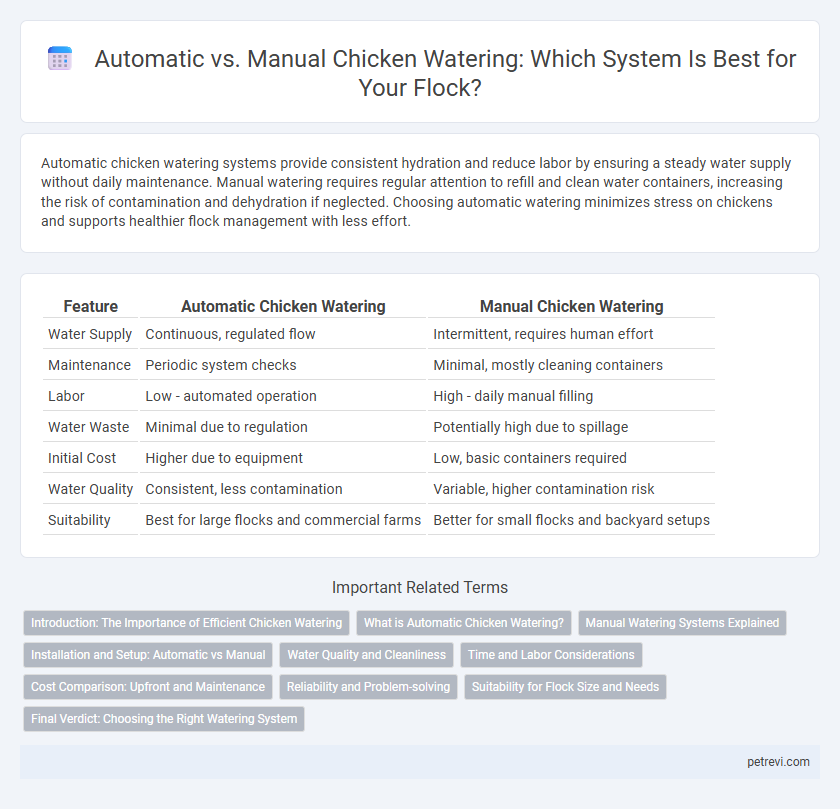Automatic chicken watering systems provide consistent hydration and reduce labor by ensuring a steady water supply without daily maintenance. Manual watering requires regular attention to refill and clean water containers, increasing the risk of contamination and dehydration if neglected. Choosing automatic watering minimizes stress on chickens and supports healthier flock management with less effort.
Table of Comparison
| Feature | Automatic Chicken Watering | Manual Chicken Watering |
|---|---|---|
| Water Supply | Continuous, regulated flow | Intermittent, requires human effort |
| Maintenance | Periodic system checks | Minimal, mostly cleaning containers |
| Labor | Low - automated operation | High - daily manual filling |
| Water Waste | Minimal due to regulation | Potentially high due to spillage |
| Initial Cost | Higher due to equipment | Low, basic containers required |
| Water Quality | Consistent, less contamination | Variable, higher contamination risk |
| Suitability | Best for large flocks and commercial farms | Better for small flocks and backyard setups |
Introduction: The Importance of Efficient Chicken Watering
Efficient chicken watering systems ensure consistent hydration, which is vital for optimal growth and egg production. Automatic watering systems provide accurate water delivery and reduce labor by maintaining constant water availability, minimizing risks of contamination or dehydration. Manual watering requires frequent attention and can lead to inconsistent water supply, affecting flock health and productivity.
What is Automatic Chicken Watering?
Automatic chicken watering systems use sensors and timers to deliver a consistent supply of clean water, reducing the risk of contamination and dehydration. These systems often include nipple drinkers or float valves that regulate water flow based on chickens' needs. Compared to manual watering, automatic setups minimize labor while ensuring optimal hydration for healthy flock growth.
Manual Watering Systems Explained
Manual chicken watering systems require farmers or poultry keepers to regularly fill water containers by hand, ensuring fresh water availability for the flock. These systems often include simple designs such as buckets, troughs, or nipple drinkers, which need consistent monitoring to prevent contamination and dehydration. Compared to automatic systems, manual watering provides more control but demands significant labor and attention to maintain optimal hydration conditions for chickens.
Installation and Setup: Automatic vs Manual
Automatic chicken watering systems require a more complex installation involving plumbing connections, pressure regulators, and secure mounting to ensure consistent water flow and prevent leaks. Manual watering setups are simpler to install, often requiring only a clean water container or trough that can be refilled daily without specialized tools or equipment. While automatic systems demand upfront time and technical effort for setup, they reduce daily labor by providing continuous water access to chickens.
Water Quality and Cleanliness
Automatic chicken watering systems enhance water quality by delivering a continuous supply of fresh, filtered water, minimizing contamination risk from dirt and feces. Manual watering requires frequent cleaning and refilling to prevent bacterial growth and debris accumulation, which can compromise water cleanliness and bird health. Consistent water quality in automatic systems reduces disease outbreaks, promoting better flock hygiene and growth.
Time and Labor Considerations
Automatic chicken watering systems significantly reduce labor demands by delivering consistent water flow without daily manual intervention, saving hours of maintenance time each week. Manual watering requires frequent refilling and cleaning, increasing labor intensity and the risk of inconsistent water supply that can affect flock health. Time efficiency and reduced labor costs make automatic watering systems a preferred choice for large-scale poultry operations seeking to optimize daily routines.
Cost Comparison: Upfront and Maintenance
Automatic chicken watering systems involve higher upfront costs, typically ranging from $50 to $200 depending on the setup, while manual systems can be as low as $10 with basic supplies. Maintenance expenses for automatic systems include replacement parts like valves or nipples, averaging around $10 to $30 annually, whereas manual watering requires minimal ongoing costs but more labor time. Evaluating long-term cost efficiency, automatic systems reduce labor but increase initial investment and occasional maintenance, making them suitable for larger flocks or commercial operations.
Reliability and Problem-solving
Automatic chicken watering systems offer consistent water supply with minimal human intervention, reducing the risk of dehydration and ensuring reliable hydration for flock health. Manual watering requires regular monitoring and can lead to inconsistencies or missed refills, increasing the potential for stress and illness among chickens. Automatic systems with built-in sensors and fail-safes provide faster problem-solving capabilities by detecting leaks or blockages early, enhancing overall reliability compared to manual methods.
Suitability for Flock Size and Needs
Automatic chicken watering systems are ideal for large flocks, providing consistent water supply and reducing labor by using continuous flow or nipple drinkers that prevent contamination. Manual watering suits smaller flocks, offering flexibility and easier monitoring of individual birds' water intake but requires regular attention to prevent dehydration. Choosing between automatic and manual methods depends on flock size, farm management capacity, and specific hydration needs for optimal poultry health.
Final Verdict: Choosing the Right Watering System
Choosing the right chicken watering system depends on flock size, maintenance preference, and water source reliability. Automatic watering systems provide consistent hydration with minimal labor and reduce contamination risks, ideal for larger flocks or busy caretakers. Manual watering remains cost-effective and simple for small-scale keepers but requires regular attention to ensure chickens always have clean water.
Automatic vs Manual for Chicken Watering Infographic

 petrevi.com
petrevi.com